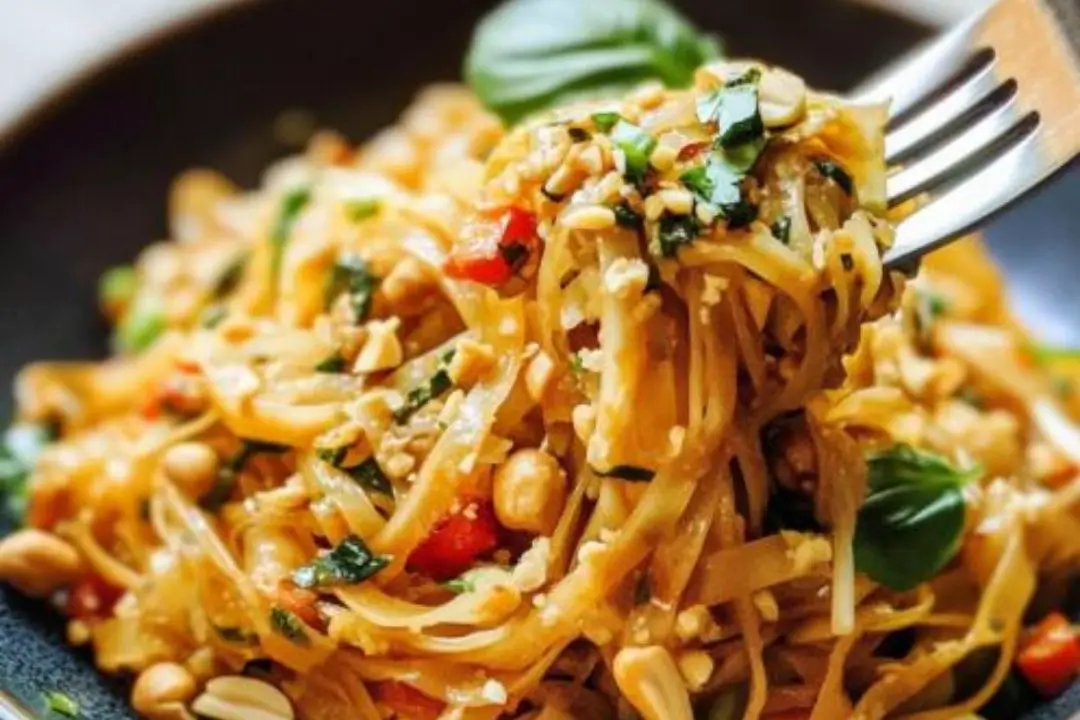Introduction
Rainbow Vegetarian Pad Thai is a vibrant and flavorful dish featuring colorful vegetables, chewy rice noodles, and a tangy, savory sauce. This vegetarian version of the classic Thai favorite is perfect for a quick weeknight dinner or a special occasion.
Ingredients
For the Pad Thai:
- 8 oz rice noodles
- 2 tablespoons vegetable oil
- 1 onion, thinly sliced
- 3 garlic cloves, minced
- 1 red bell pepper, thinly sliced
- 1 yellow bell pepper, thinly sliced
- 1 medium carrot, julienned
- 1 zucchini, julienned or spiralized
- 1 cup purple cabbage, shredded
- 1 cup bean sprouts
- 2 eggs, lightly beaten (optional for added protein)
- 1/4 cup fresh basil, chopped
- 1/4 cup roasted peanuts, chopped
- Lime wedges, for serving
For the Sauce:
- 3 tablespoons soy sauce or tamari (for gluten-free)
- 2 tablespoons tamarind paste (or substitute with lime juice for tang)
- 2 tablespoons brown sugar or coconut sugar
- 1 tablespoon rice vinegar
- 1 tablespoon chili garlic sauce or sriracha (optional, for heat)
- 1 tablespoon peanut butter (optional, for a creamier sauce)
Directions
- Cook the Rice Noodles:
- Prepare the rice noodles according to the package instructions. This usually involves soaking them in warm water for 10-15 minutes until they are soft but not mushy. Drain and set aside.
- Prepare the Sauce:
- In a small bowl, whisk together the soy sauce, tamarind paste (or lime juice), brown sugar, rice vinegar, chili garlic sauce (if using), and peanut butter (if using) until smooth. Set aside.
- Stir-Fry the Vegetables:
- Heat the vegetable oil in a large skillet or wok over medium-high heat. Add the sliced onion and garlic, sauté for 2-3 minutes until fragrant.
- Add the bell peppers, carrots, zucchini, and cabbage. Stir-fry for about 4-5 minutes until the vegetables are tender but still crisp.
- Cook the Eggs (Optional):
- If using eggs, push the vegetables to one side of the skillet and pour the beaten eggs onto the other side. Scramble the eggs until fully cooked, then mix them with the vegetables.
- Add the Noodles and Sauce:
- Add the drained rice noodles to the skillet and pour the prepared sauce over them. Toss everything together to ensure the noodles and vegetables are evenly coated with the sauce. Add the bean sprouts and cook for another 2-3 minutes to heat through.
- Finish and Serve:
- Remove from heat and stir in the chopped fresh basil. Serve the Rainbow Vegetarian Pad Thai hot, garnished with chopped peanuts, extra basil, and lime wedges for squeezing on top.
Servings and Timing
- Servings: 4
- Preparation Time: 15 minutes
- Cook Time: 15 minutes
- Total Time: 30 minutes
Variations
- Protein Add-ins: Add tofu, tempeh, or cooked chicken for extra protein.
- Vegetable Variations: Swap out vegetables based on what’s in season or your personal preferences, such as adding mushrooms or snap peas.
- Spice Level: Adjust the heat by increasing or decreasing the chili garlic sauce or sriracha.
Storage/Reheating
- Storage: Store leftovers in an airtight container in the refrigerator for up to 3 days.
- Reheating: Reheat in a skillet over medium heat or in the microwave until heated through. Add a splash of water or vegetable broth if the noodles have dried out.
10 FAQs
- Can I use a different type of noodle?
- Yes, you can substitute rice noodles with soba noodles or any other stir-fry-friendly noodles.
- Is tamarind paste essential?
- Tamarind paste provides authentic flavor, but you can substitute with lime juice for a tangy alternative.
- Can I make this dish gluten-free?
- Use tamari instead of soy sauce and ensure all other ingredients are gluten-free.
- How do I make this dish spicier?
- Add more chili garlic sauce or sriracha to increase the heat level.
- Can I prepare this dish ahead of time?
- You can prepare the vegetables and sauce in advance, but it’s best to cook the noodles and combine everything just before serving.
- What can I use instead of peanuts?
- Almonds, cashews, or sunflower seeds are good alternatives if you have a nut allergy.
- Can I use frozen vegetables?
- Yes, frozen vegetables can be used; just be sure to thaw and drain them before cooking.
- What should I serve with this dish?
- This Pad Thai pairs well with a side of spring rolls, a fresh salad, or a light soup.
- Can I freeze leftovers?
- While you can freeze leftovers, the texture of the noodles may change. Store in an airtight container for up to 2 months.
- How do I adjust the sweetness or tanginess?
- Adjust the amount of brown sugar or tamarind paste (or lime juice) according to your taste preferences.
Conclusion
Rainbow Vegetarian Pad Thai is a vibrant, healthy twist on the classic Thai dish. With colorful vegetables and a flavorful sauce, it’s perfect for a quick weeknight meal or a festive dinner. Customize it to your taste and enjoy a delicious, plant-based meal that’s both satisfying and easy to prepare.
Print
Rainbow Vegetarian Pad Thai with Peanuts and Basil
- Total Time: 30 minutes
- Yield: 4 servings 1x
Description
Rainbow Vegetarian Pad Thai is a vibrant, plant-based version of the classic Thai dish. It features colorful vegetables, chewy rice noodles, and a tangy, savory sauce, topped with peanuts and fresh basil. This dish is perfect for a healthy, satisfying meal any day of the week.
Ingredients
For the Pad Thai:
- 8 oz rice noodles
- 2 tablespoons vegetable oil
- 1 onion, thinly sliced
- 3 garlic cloves, minced
- 1 red bell pepper, thinly sliced
- 1 yellow bell pepper, thinly sliced
- 1 medium carrot, julienned
- 1 zucchini, julienned or spiralized
- 1 cup purple cabbage, shredded
- 1 cup bean sprouts
- 2 eggs, lightly beaten (optional for added protein)
- 1/4 cup fresh basil, chopped
- 1/4 cup roasted peanuts, chopped
- Lime wedges, for serving
For the Sauce:
- 3 tablespoons soy sauce or tamari (for gluten-free)
- 2 tablespoons tamarind paste (or substitute with lime juice for tang)
- 2 tablespoons brown sugar or coconut sugar
- 1 tablespoon rice vinegar
- 1 tablespoon chili garlic sauce or sriracha (optional, for heat)
- 1 tablespoon peanut butter (optional, for a creamier sauce)
Instructions
- Cook the Rice Noodles:
- Cook the rice noodles according to package instructions, usually by soaking in warm water for 10-15 minutes until soft but not mushy. Drain and set aside.
- Prepare the Sauce:
- In a small bowl, whisk together soy sauce, tamarind paste (or lime juice), brown sugar, rice vinegar, chili garlic sauce (if using), and peanut butter (if using) until smooth. Set aside.
- Stir-Fry the Vegetables:
- Heat vegetable oil in a large skillet or wok over medium-high heat. Add sliced onion and garlic, sauté for 2-3 minutes until fragrant.
- Add bell peppers, carrots, zucchini, and cabbage. Stir-fry for 4-5 minutes until vegetables are tender but still crisp.
- Cook the Eggs (Optional):
- If using, push vegetables to one side of the skillet and pour beaten eggs onto the other side. Scramble eggs until fully cooked, then mix with vegetables.
- Add the Noodles and Sauce:
- Add drained rice noodles to the skillet and pour sauce over the top. Toss everything to coat noodles and vegetables evenly with sauce. Add bean sprouts and cook for another 2-3 minutes.
- Finish and Serve:
- Remove from heat and stir in chopped fresh basil. Serve hot, garnished with chopped peanuts, extra basil, and lime wedges.
Notes
- Tamarind Paste: Provides an authentic tangy flavor but can be substituted with lime juice if unavailable.
- Optional Protein: Tofu or tempeh can be added for extra protein.
- Gluten-Free: Use tamari instead of soy sauce and check all other ingredients.
- Prep Time: 15 minutes
- Cook Time: 15 minutes
- Category: Main Course
- Method: Stir-Frying
- Cuisine: thai
Nutrition
- Serving Size: 1/4 of the recipe
- Calories: 400 kcal
- Sugar: 12g
- Sodium: 800mg
- Fat: 14 g
- Saturated Fat: 2g
- Unsaturated Fat: 12 g
- Trans Fat: 0g
- Carbohydrates: 60 g
- Fiber: 6 g
- Protein: 12g
- Cholesterol: 0 mg




